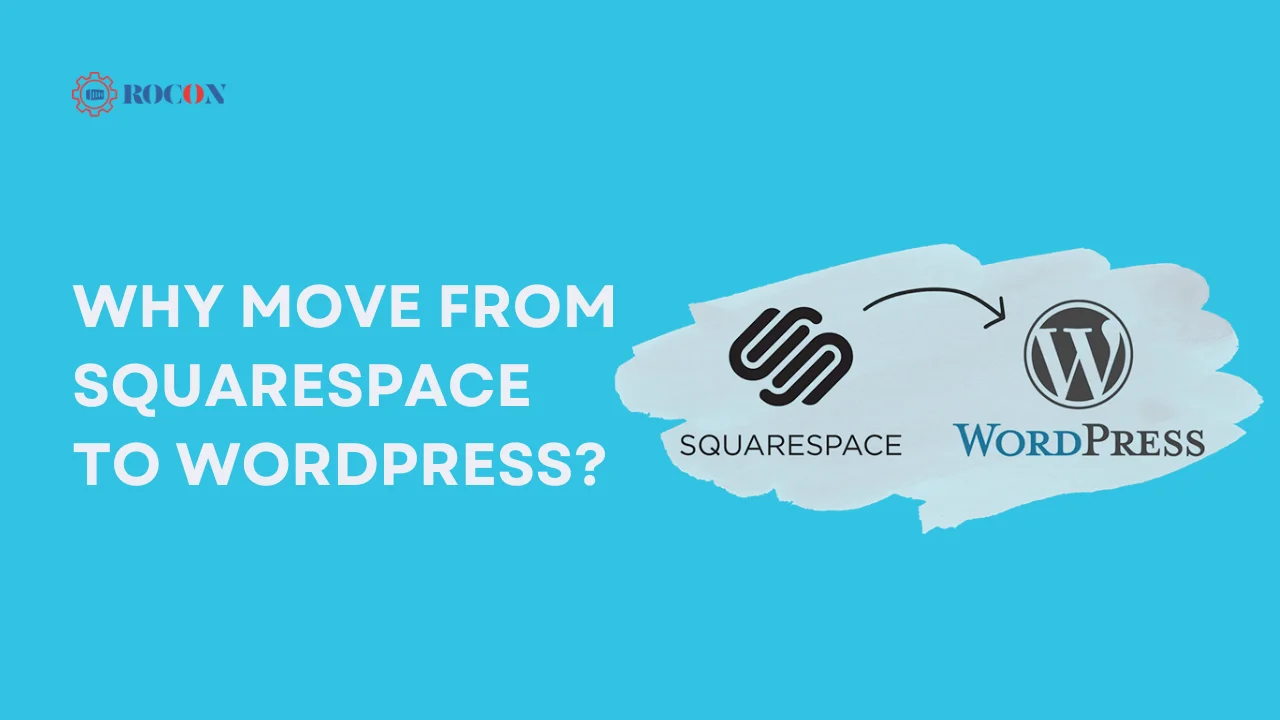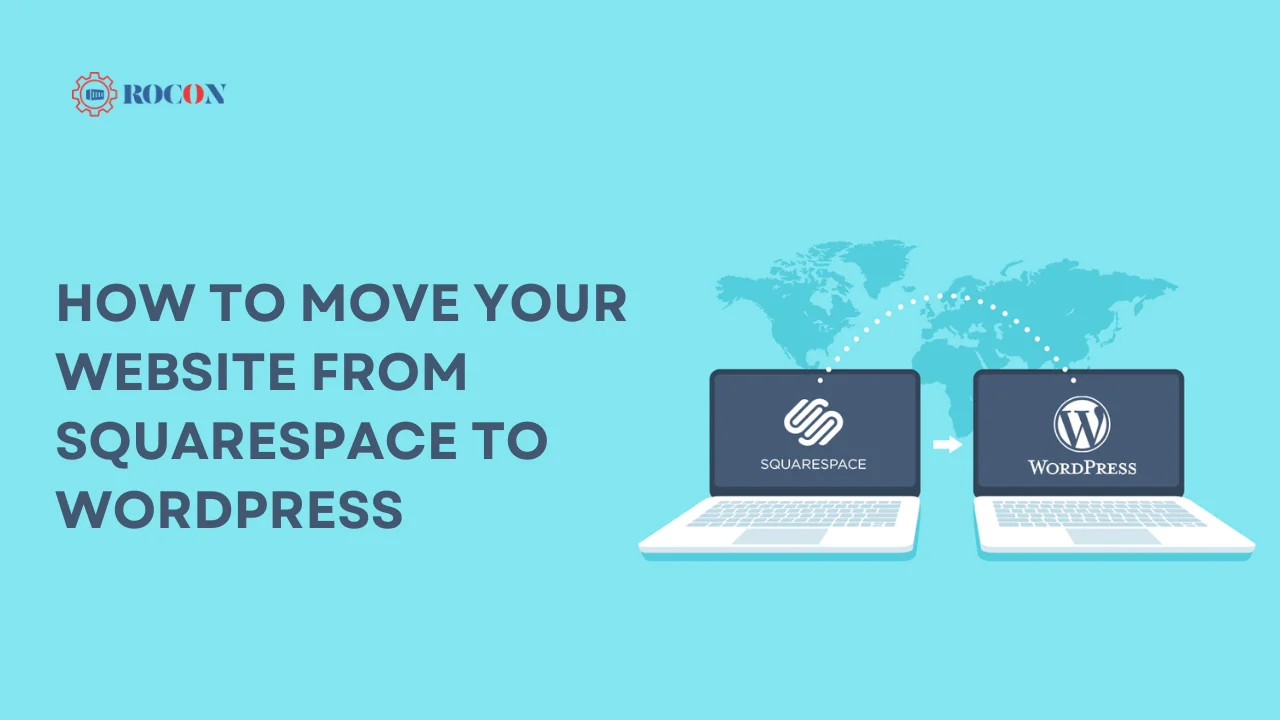Introduction
How to Move Website From Squarespace to WordPress: Squarespace is a popular website builder that offers an all-in-one platform for users to create visually appealing websites with ease.
However, as your website grows, you may find that Squarespace’s limitations become apparent—especially in terms of customization, scalability, and control.
Many website owners choose to move from Squarespace to WordPress to take advantage of the flexibility, wide range of plugins, and customization options that WordPress offers.
If you’re wondering can you transfer a Squarespace website to WordPress or can I move my website from Squarespace to WordPress, you’re not alone. This article will guide you through the process of how to transfer your website from Squarespace to WordPress—including how to transfer your domain, why it’s beneficial, and what tools or agency services can help make it effortless.
We’ll also introduce Rocon, a hosting provider that offers free migration services and excellent customer support throughout the entire process.
Why Move from Squarespace to WordPress?

There are several compelling reasons why website owners move from Squarespace to WordPress:
- Flexibility and Customization: While Squarespace offers excellent design templates, it has limited customization options. WordPress, on the other hand, offers thousands of themes and plugins that allow you to customize your site in virtually any way.
- Ownership and Control: With Squarespace, you’re limited to the tools and features provided by the platform. WordPress, being open-source, gives you complete control over your website’s design, functionality, and hosting, ensuring you own and control your data.
- Scalability: As your business or website grows, Squarespace’s capabilities can become restrictive. WordPress is highly scalable and can accommodate everything from personal blogs to enterprise-level e-commerce sites.
- SEO and Performance: WordPress is more SEO-friendly and allows for a variety of tools (such as Yoast SEO) that provide deeper optimization than Squarespace. You can also tweak your site’s speed and performance settings with caching plugins and performance-boosting features.
- Cost-Effectiveness: WordPress is generally more cost-effective in the long term, as you have greater control over hosting providers, which allows you to select a plan that suits your budget and scale as needed.
- Plugin Ecosystem: WordPress has over 59,000+ free plugins — everything from email opt-ins to booking systems. You’re not stuck with limited Squarespace features anymore.
- Huge Community & Support: WordPress powers over 43% of the entire internet — there’s a massive global community, tutorials, forums, developers, and support resources.
Why Should I Move My Website to WordPress?
You might ask yourself, why should I move my website to WordPress when Squarespace already offers beautiful templates and a simple interface? The reason is control and growth. WordPress provides full design freedom, plugin options, SEO control, and performance flexibility that Squarespace lacks.
Preparing for the Migration
Before starting the migration process, it’s essential to prepare your new WordPress site and gather all necessary data from your Squarespace site. This ensures a smooth transition without data loss or extended downtime.
1. Choose the Right WordPress Hosting Provider
The first step is to choose a hosting provider for your new WordPress website. Since WordPress is self-hosted, you’ll need a hosting service that provides good performance, security, and customer support. One hosting provider that stands out, especially for migrations, is Rocon.
If you’re specifically looking for an agency that can migrate my site from Squarespace to WordPress, Rocon provides complete white-glove service. From exporting your content to redesigning your layout and migrating your domain, they ensure everything is transferred accurately and stress-free.

- Rocon offers free migration services, meaning they’ll handle the entire migration process from Squarespace to WordPress for you. This can save you time and reduce the risk of errors during the transition.
- They also provide 24/7 customer support, ensuring you get help whenever you need it throughout the migration process.
Other hosting providers you might consider include:
- SiteGround: Known for its excellent performance and security features.
- Bluehost: A WordPress-recommended hosting provider offering affordable plans.
- Kinsta: A premium hosting provider with top-tier performance and scalability.
2. Install WordPress on Your New Hosting
Once you’ve chosen a hosting provider, the next step is to install WordPress on your hosting account. Most hosting providers, including Rocon, offer one-click WordPress installation through their control panels, which makes the process simple and straightforward.
After WordPress is installed, you’ll be able to choose a theme. For a seamless transition, you might want to select a WordPress theme that closely matches your current Squarespace design, though WordPress themes are more flexible and customizable.
3. Backup Your Squarespace Website
Before migrating your site, make sure you back up all content on Squarespace to avoid data loss during the transfer. Squarespace doesn’t offer a full backup or export feature, so you’ll need to manually save certain content:
- Pages and Blog Posts: You can export some content (mainly pages and blog posts) using Squarespace’s export feature.
- Images and Media: Download all images and media files manually from Squarespace since they are not included in the export file.
- Custom Code: If you’ve added any custom CSS or HTML, copy and save this code separately for later use in WordPress.
- Domain Transfer: Don’t forget your domain—many users also search for how to transfer domain from Squarespace to WordPress. It involves unlocking your domain in Squarespace and updating your DNS or transferring your domain registrar to your new hosting provider like Rocon.
How to Move Your Website from Squarespace to WordPress

Now that you’ve prepared your hosting environment and backed up your Squarespace content, you’re ready to start the migration process. Here’s a step-by-step guide:
1. Export Content from Squarespace
Squarespace offers a built-in export tool, but it has some limitations. Follow these steps to export your content:
- Go to Settings > Advanced > Import/Export in your Squarespace dashboard.
- Select Export and choose the WordPress icon as the export format.
Squarespace will generate an XML file containing your pages and blog posts. Keep in mind:
- Only blog posts, regular pages, and embedded images will be exported.
- Products, event pages, and gallery sections will not be included, so you’ll need to manually recreate these in WordPress.
2. Import Content into WordPress
Now that you’ve exported your content from Squarespace, it’s time to import it into WordPress:
- In your WordPress dashboard, go to Tools > Import.
- Click Install Now under the WordPress importer, then select Run Importer.
- Upload the XML file you exported from Squarespace.
After the import is complete, your blog posts and basic pages will appear in WordPress.
3. Manually Transfer Any Missing Content
Since the Squarespace export file doesn’t include everything, you’ll need to manually transfer missing content, such as:
- Images and Galleries: Rebuild image galleries using a WordPress gallery plugin, such as NextGEN Gallery, and upload images into your WordPress media library.
- Products and E-commerce Data: If your site includes products or e-commerce features, you’ll need to manually recreate product pages using WooCommerce or another e-commerce plugin.
- Custom CSS or HTML: Add any custom code you used in Squarespace by navigating to Appearance > Customize > Additional CSS in your WordPress dashboard.
4. Choose a WordPress Theme
One of the benefits of WordPress is the extensive variety of themes available. Choose a theme that matches your website’s look and feel, or explore new design options that take advantage of WordPress’s flexibility.
You can customize themes further with page builders like Elementor or WPBakery, giving you full control over the design.
Optimizing Your WordPress Site After Migration
Once you’ve migrated your content, there are a few additional steps to optimize your WordPress site for performance, security, and SEO:
1. Install Essential Plugins
WordPress offers thousands of plugins that can enhance your site’s functionality. Here are some essential plugins to consider:
- Yoast SEO: Optimize your website for search engines with easy-to-use SEO tools.
- Wordfence Security: Enhance security by scanning for malware and blocking suspicious activity.
- WP Super Cache or W3 Total Cache: Improve your site’s performance by caching content and reducing load times.
- WooCommerce: If you had an e-commerce store on Squarespace, WooCommerce is the best solution for recreating your online store in WordPress.
2. Optimize for SEO
With WordPress, you have more control over SEO than with Squarespace. Use plugins like Yoast SEO or Rank Math to optimize your meta descriptions, keywords, and other on-page SEO elements. Ensure your URL structure, alt text for images, and internal linking are set up correctly to boost your site’s search engine ranking.
3. Secure Your Site
WordPress is a highly secure platform, but it’s essential to take additional measures. Install security plugins like Wordfence or Sucuri Security to protect your site from malware, brute-force attacks, and hacking attempts. Make sure to keep your WordPress core, themes, and plugins updated to the latest versions.
4. Test and Launch
Once the migration is complete, thoroughly test your website to ensure everything works as expected. Test all pages, links, and forms, and check for broken images or formatting errors. When everything looks good, it’s time to launch your new WordPress site.
Switching from Squarespace to WordPress? Choose Rocon
Migrating from Squarespace to WordPress can feel like a daunting process, but with the right preparation and hosting provider, it can be a smooth and rewarding experience.
If you’re looking for a reliable hosting provider that offers free migration services and excellent customer support, Rocon is an ideal choice. They will handle the technical aspects of the migration, allowing you to focus on building and optimizing your new WordPress site.
With WordPress’s unparalleled flexibility, SEO advantages, and scalability, you’ll have more control over your website’s future, making it a powerful platform to grow your online presence.
Whether you’re a small business, a blogger, or an e-commerce store owner, migrating to WordPress will open up new opportunities for customization and growth.
How to Move Website From Squarespace to WordPress FAQs
1. Squarespace vs WordPress – which is better?
There’s no winner here — it depends on your goals. Squarespace is great for beginners who want an all-in-one platform with beautiful templates and easy setup. But if you need more flexibility, scalability and control over hosting, design and plugins then WordPress is the way to go — especially for bigger projects or growing businesses.
2. How do I transfer my website from Squarespace to WordPress?
You can transfer your website from Squarespace to WordPress by exporting your content from Squarespace, setting up WordPress, and importing your content into the new platform. It’s important to manually move design elements, images, and SEO settings for a smoother transition. Using a managed hosting provider like Rocon can make this process much easier.
3. Can I transfer my Squarespace blog posts to WordPress?
Yes you can export your Squarespace blog posts and import them into WordPress using the default WordPress importer. Some formatting may need to be manually adjusted after the import.
4. Do I need coding skills to migrate from Squarespace to WordPress?
Not necessarily. While some technical knowledge helps, platforms like Rocon offer guided migrations or you can use migration plugins or hire professionals to handle the transition.
5. Do I need to change my domain when switching to WordPress?
No you can keep your existing domain. Just point your domain’s DNS to your new WordPress host (e.g. Rocon) after the migration is complete.
6. Can you transfer a Squarespace website to WordPress?
Yes, you can transfer a Squarespace website to WordPress using the export and import method. While not all content transfers automatically, key pages and blog posts can be exported via XML, and the rest can be manually recreated in WordPress.
7. How to transfer domain from Squarespace to WordPress?
To transfer your domain, go to Squarespace’s domain settings, unlock the domain, and get the authorization (EPP) code. Then, initiate the domain transfer in your new WordPress host like Rocon. Alternatively, update DNS settings if you’re keeping the domain registrar with Squarespace.

Leave a Reply